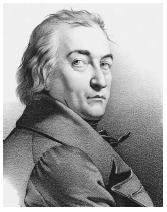Claude-Louis Berthollet

FRENCH CHEMIST
1748–1822
Claude-Louis Berthollet was influential in four areas: theoretical chemistry, experimental chemistry, practical chemistry, and chemical writing. He was also a chemistry teacher and, with his contemporary Pierre-Simon de Laplace, a patron of young French scientists. Born in 1748 in the town of Talloire, near Annecy, France, Berthollet studied medicine at the University of Turin. Arriving in Paris in 1772, he soon found a medical patron in one of the great Parisian aristocrats, Louis-Philippe, duke of Orléans. To consolidate his professional status, Berthollet obtained a medical degree at the University of Paris and continued to practice medicine until the mid-1780s. During the 1770s he had acquired an active interest in chemistry. By 1780 he had presented eighteen mémoires to the Académie des Sciences. He was admitted to the Académie as an adjoint in 1780, promoted to associé in 1785, and promoted to its highest position, pensionnaire , in 1792.
By the early 1780s, Berthollet had gained entrance to the circle of chemists that surrounded Antoine-Laurent Lavoisier, who had been developing his new oxygen-based, antiphlogistic theory of chemistry. Although Berthollet at first criticized features of the new chemistry (and never did accept Lavoisier's oxygen-based theory of acidification), he was the first chemist of Lavoisier's circle to formally and publicly become a supporter. In 1787 he joined with Lavoisier's other close associates (including Antoine Fourcroy and Louis-Bernard Guyton de Morveau) to forge a chemical nomenclature that would be coordinated with the new chemistry.
In 1784 Berthollet was appointed to the post of inspector of the dye works and director of manufacture at the Gobelin tapestry works. While studying the properties of newly discovered chlorine gas ("dephlogisticated marine acid"), Berthollet recognized its superior bleaching properties, and he developed a chlorine-based bleach. In 1791 Berthollet published Élémens de l'art de la teinture , a systematic study and scientific discussion of the nature of dyeing. Berthollet also contributed to another scientific study of a major industry of the 1780s: ironmaking and steelmaking. In this study an attempt was made to provide a scientific explanation of the different kinds of iron (cast, wrought) and steel based on degrees of reduction (removal of oxygen) of the ore and subsequent combination with carbon. A third area of practical chemistry in which Berthollet was active was munitions. His most significant work in this area was the development of a potassium chlorate–based explosive (which turned out to be too powerful for use as a munition).
During the French Revolution and the Napoleonic era, Berthollet came to play active civic and political roles in France. During the Revolution, he was one of the scientists entrusted by the Committee of Public Safety with the emergency amplification of munitions production. He taught at the École Normale and was one of the founders of the École Polytechnique. He became a friend of Napoleon Bonaparte, whom he accompanied to Egypt in 1798, and in Egypt helped to set up a scientific institute along the lines of the Parisian Académie. Under the aegis of Napoleon, Berthollet was made a count, a senator of Montpellier, and a grand officier of the Légion d'Honneur.
Although Berthollet never published a textbook of chemistry, he did publish the Essai de statique chimique (1803), an ambitious work that attempted to provide a systematic theoretical foundation for chemistry. Like his predecessors, Berthollet conceived of the microscopic-level forces by which chemical substances "attracted" one another as being the same as or analogous to gravity. But Berthollet challenged his predecessors' view that the strengths of chemical affinity forces were determined solely by the nature of the reagents and were invariant under all physical and chemical condition. He held that factors such as the masses of the reagents, their physical states before and after the reaction, and general physical circumstances could affect the directions of reactions and even the combining proportions of their products.
Regarding combining proportions, Berthollet asserted that chemical reagents in continuous ranges of weight proportions could combine, depending on the masses of the reagents and the physical circumstances of the reactions. By this time, Joseph-Louis Proust had already set forth his general assertion that true chemical combination was always marked by fixed-weight proportions of the reagents. Berthollet and Proust argued the issue in print for several years without any resolution of the argument. What "settled" the issue was the ascendancy of John Dalton's chemical atomic theory(1808), which in its laws of definite and multiple proportions supported Proust's position.
SEE ALSO Dalton, John ; Lavoisier, Antoine .
Seymour Mauskopf
Comment about this article, ask questions, or add new information about this topic: